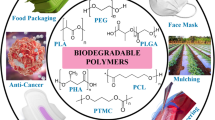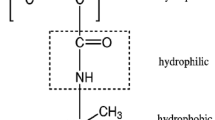Summary
A novel well-defined macromonomer consisting of different types of monomers in polymerization mechanisms was synthesized for the first time through the SmI2-induced transformation. The macromonomer, ω-methacryloylpoly-(tetrahydrofuran-b-ε-caprolactone), was prepared by the reaction of methacryloyl chloride with living poly(tetrahydrofuran-b-ε-caprolactone) [poly(THF-b-CL)] which was obtained by the two-electron reduction of the cationic growing center of poly(THF) by samarium iodide (SmI2) followed by the polymerization of CL. 1H NMR analysis indicated the quantitative introduction of the methacryloyl group onto the polymer end. The molecular weight distribution of the macromonomer was relatively narrow, and the unit ratio of THF to CL could be controlled by both polymerization time of THF and the amount of CL, resulting from the living nature of both CL- and THF-polymerizations. Radical copolymerization of the produced macromonomers with methyl methacrylate in the presence of AIBN resulted in a polymethacrylate backbone grafted with poly(THF-b-CL) block copolymers.
Similar content being viewed by others
References and Notes
Recent examples for preparation of diblock macromonomers: K. Ishizu, S. Yukimasa, R. Saito, J. Polym. Sci., Polym. Chem., 31, 3073 (1993).
K. Ishizu, K. Kuwahara, J. Polym. Sci., Polym. Chem., 31, 661 (1993).
K. Ishizu, Polym.-Plast. Technol. Eng., 32, 511 (1993).
I. V. Berlinova, I. M. Panayotov, Makromol. Chem., 190, 1515 (1989).
M. Niwa, N. Higashi, Macromolecules, 21, 1191 (1988).
K. Ishizu, K. Shimomura, R. Saito, T. Fukutomi, J. Polym. Sci., Polym. Chem. 29, 607 (1991).
A review of transformation reactions: F. Schué, Comprehensive Polymer Science; G. C. Eastmond, A. Ledwith, S. Russo, P. Sigwalt, Eds.; Pergamon Press: Oxford, Great Britain, 1989; Vol. 6, Chapter 10, p 359.
R. Nomura, T. Endo, Macromolecules, 27, 5523 (1994).
R. Nomura, M. Narita, T. Endo, Macromolecules, 27, 4853 (1994).
R. Nomura, M. Narita, T. Endo, Macromolecules, 27, 7011 (1994).
R. Nomura, M. Narita, T. Endo, Macromolecules, 28, 86 (1996).
R. Nomura, T. Endo, Macromolecules, 28, 1754 (1995).
The homopolymerization of CL took place in the case of employing excess of SmI2 to the initiator, which resulted in the contamination of telechelic poly(CL) having two polymerizable groups at both polymer ends. The run 4 in Table 1 showed larger functionality than the theoretical value, which might be because of the presence of excess of SmI2. Evans et al. have reported that SmI2 itself could not initiate the polymerization of CL in THF at ambient temperature [5]. However, the SmI2 was active for CL-polymerization in the presence of HMPA.
W. J. Evans, H. Katsumata, Macromolecules, 27, 2330 (1994).
P. Girard, J. L. Namy, H. B. Kagan, J. Am. Chem. Soc., 102, 2693 (1980).
Author information
Authors and Affiliations
Rights and permissions
About this article
Cite this article
Nomura, R., Endo, T. Synthesis of poly(tetrahydrofuran-b-ε-caprolactone) macromonomer via the Sml2-induced transformation. Polymer Bulletin 35, 683–689 (1995). https://doi.org/10.1007/BF00294950
Received:
Revised:
Accepted:
Issue Date:
DOI: https://doi.org/10.1007/BF00294950




